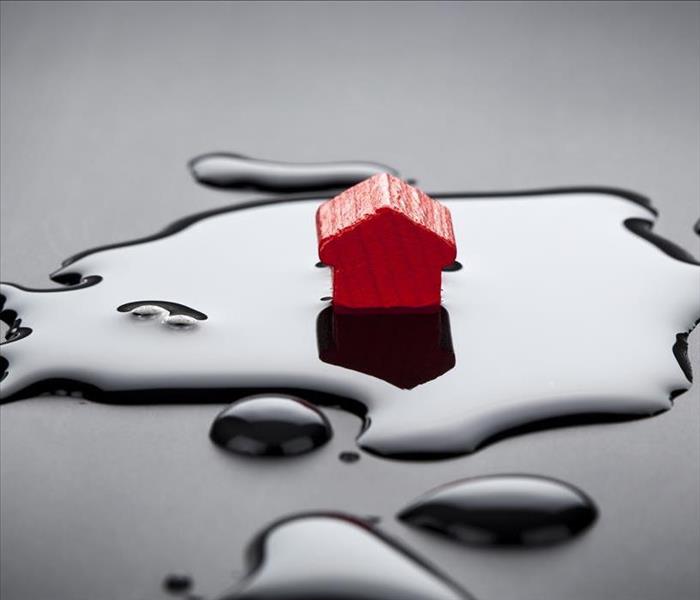How Bad is the Flood Damage in My Bridgewater House?
4/16/2020 (Permalink)
 Flood damage can result anywhere in your home. Call the professionals at SERVPRO today for remediation assistance.
Flood damage can result anywhere in your home. Call the professionals at SERVPRO today for remediation assistance.
Our SERVPRO Team Has Advanced Discovery Tools to Identify Moisture and Water Damage to Dry Your Home Quickly.
It might not always be as apparent as you might think when your Bridgewater home is suffering widespread effects of penetrating floodwater. While you can see the areas on the surface that have become affected by the intruding threat, you cannot tell how materials and structural cavities have become affected as well. By leaving these areas unchecked and unresolved, you can welcome harmful secondary effects like mold growth or structural deterioration.
Flood damage to Bridgewater homes is rarely only the intruding water that you can see. Identifying the full scope of the damage involves sophisticated tools and dedicated personnel of our SERVPRO team trained to assess what work needs to happen and which tools can accomplish these tasks. The proper blend of job scoping, and moisture detection technology can ensure that drying and extraction processes resolve the issues entirely.
Is Job Scoping a Part of Flood Recovery?
Scoping is a vital element to every loss recovery job that our professionals undertake. Through advanced software like DryBook, we can catalog damaged contents and areas of the property that need to get addressed. The intentions of spending this initial time evaluating the condition of the house are to reduce adverse conditions like:
- Structural Compromise
Exposure of floodwater to many of the construction materials in your home can lead to situations where these materials begin to weaken. Prolonged exposure to sensitive and absorbent materials like wood flooring and drywall can lead to scenarios where there is no other choice but to remove these elements and replace them at a later point.
- Water Migration
Reducing the spread of water damage can help to better protect the structural elements and the contents of your home as much as possible. We have intricate tools and advanced technologies that can help to identify the current positioning of moving water and track the path of its migration from the source.
- Content Conditions
Job scoping often details the damage to your personal belongings and items throughout the house. In many situations, it is possible to clean and restore these possessions, but that is a determination that can get made preliminarily during the scoping. The condition of these contents determines whether they can get cleaned and stored on-site or if they need to get relocated to our nearby SERVPRO warehouse.
- Contamination Concerns
Natural flooding can welcome threats like contamination to your home. Storm damage flooding like holes in the roof or missing siding does not often come with the threat of bacterial contamination threats. Water coming in from floor drains or pouring in from the ground floor gets considered to be on par with a biohazardous situation.
What Tools Can Identify Moisture Damage After a Flood?
Many tools play a specific role in identifying the spread and severity of water losses after a flood. Taking note of the condition of your home beyond the surface materials can ensure that all of the moisture gets dried up and that the appropriate steps occur to clean and disinfect exposed structural elements like wood framing when necessary.
Identifying moisture pockets does not fall to one tool or system alone. We have multiple techniques and scientific devices designed to help, including:
- Surface Moisture Meters
- Hygrometers
- Thermal Imagery
- Probing Moisture Detection Equipment
How Does SERVPRO Dry My Flood-Damaged Home?
Drying is one of the most critical approaches to our entire restoration process, as failure to adequately achieve this can lead to even greater damages for your property. We have multiple tools that we can rely on to accomplish this often substantial task after a flood, and these include:
- Air Movers
High-velocity air movers are among the staples of sufficient drying for your flooded property. Centrifugal air movers are vital in removing moisture from specific positions on a damaged structural surface while axial machines address moisture in an open environment.
- Positive Pressure Systems
Structural cavities can often be a place where moisture and dampness can exist after surface conditions have returned to normal. Once these moisture pockets get identified, we can utilize positive pressure systems to introduce heated blasts of air through multiple hoses into the wall cavity. Success for this machine reduces the need for removal.
- Dehumidifiers
Moisture removal tools like dehumidifiers help to regulate humidity in the house. Reducing humid conditions can help to maximize the drying production of air movers and other drying tools.
- Portable Electric Heaters
Regulating the temperature of damp surfaces and environments that need to get dried can help to increase evaporation. We use portable electric heaters to increase temperatures in drying zones.
Things can feel uncertain and stressful after a flood, but our SERVPRO of Bridgewater team can help. We have confident and experienced employees available 24/7. Give us a call today at (908) 222-2020.






 24/7 Emergency Service
24/7 Emergency Service